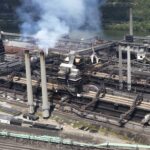According to catastrophe modeling firm AIR Worldwide Typhoon Haikui, the 11th typhoon of 2012 Pacific season, made landfall in Hepu Township in Xiangshan County of China’s Zhejiang Province at 3:20 am local time Wednesday, August 8.
Maximum sustained winds at landfall were 138 km/h [86 mph], making it a Category 1 storm. It is delivering substantial rain. According to the head of the Zhejiang provincial meteorological bureau, the storm is expected to have been in Zhejiang province for 24 hours by the time it exits to neighboring Anhui Province, to the northwest, later tonight (local time).
“The storm’s winds have been weakening over land and are expected to continue to do so,” explained Dr. Peter Sousounis, senior principal atmospheric scientist at AIR. “However, Haikui will continue to deliver large amounts of rain, raising the risk of landslides and flooding in inland locations along the storm’s projected trajectory.
“Haikui is expected to maintain its present movement (west northwest) as it tracks from northwestern Zhejiang Province into Anhui Province. A cold frontal system to the north is not strong enough to redirect Haikui towards Shanghai as was earlier thought. Because of the storm’s large size, the duration of heavy rain will likely be more than 24 hours by the time it leaves Zheijiang Province late tonight (local time).”
He added that the “weakened winds and slow-moving nature of Haikui after landfall make flooding the predominant threat. Some isolated areas have received over 200 millimeters [7 7/8 inches], and another 150 to 250 millimeters are expected to fall as Haikui continues inland, with some isolated locations receiving even greater amounts of precipitation.”
He also noted that the “vulnerability of buildings to flood damage also varies by construction type. For a given flood depth, a residential wood-frame building is expected to sustain more damage than a residential masonry building. Concrete construction is less vulnerable to flood than steel (which may experience surface corrosion and rust-induced expansion) or masonry structures (whose weak connections between building elements makes it permeable to water). Concrete buildings have a strong frame structure, but may suffer from cracking and rebar expansion. Commercial buildings, including those in the bustling hub of Shanghai, usually have stronger foundations than residential buildings, and are thus better able to resist flood loads.”
AIR said “Zhejiang province is home to more than 9 million people. Historically, adobe and brick with wood-frame have been the predominant construction types for single-family homes in China, and they are still widespread in rural areas. These are usually poorly engineered structures and generally not insured. Insured single-family homes are predominately confined masonry and reinforced concrete. Concrete is less vulnerable to flood loads, and also to lateral wind loads.”
The bulletin also indicated that Shanghai, with a population of around 23 million, situated about 225 kilometers [140 miles] north of Haiku’s landfall location, had “experienced heavy flooding,” with rainfall lasting “for nearly 17 hours beginning at 8 pm local time on August 7. As much as 58 millimeters [app. 2 ¼ inches] of rain fell in the city’s commercial center in one hour.”
Source AIR Worldwide
Was this article valuable?
Here are more articles you may enjoy.


 2 New Jersey Pilots Killed in Helicopter Collision Frequented Nearby Cafe Together
2 New Jersey Pilots Killed in Helicopter Collision Frequented Nearby Cafe Together  Longtime Motel 6 Spokesman Tom Bodett Settles Lawsuit Against Chain
Longtime Motel 6 Spokesman Tom Bodett Settles Lawsuit Against Chain  Disney Worker Injured Trying to Stop Runaway Boulder at Indiana Jones Show
Disney Worker Injured Trying to Stop Runaway Boulder at Indiana Jones Show  Board Calls for US Steel to Address Safety Issues as It Rebuilds Site of Fatal Explosion
Board Calls for US Steel to Address Safety Issues as It Rebuilds Site of Fatal Explosion 

